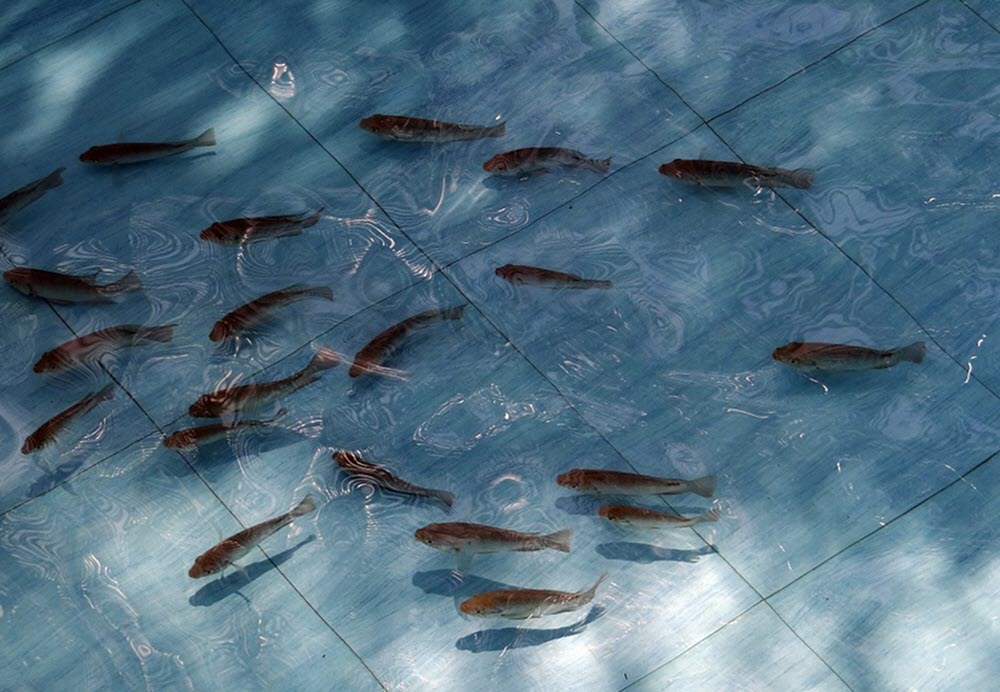Pond Culture of Tilapia
Tilapia has been grown in ponds for thousands of years within its natural geographic range and was for instance aquacultured in ponds along the River Nile by the ancient Egyptians. Today, tilapia is also raised in cages and tanks, but the traditional way of raising tilapia in outdoor ponds is still common throughout the world. Each type of growing unit has its own advantages and downsides, so it is advisable to check out the various alternatives before you make up your mind. In this article, we will take a closer look at pond culturing of tilapia.

Tilapia fingerlings in pond. Picture provided by damm
Raising tilapia in ponds
Tilapia ponds are usually not stocked as densely as cages and tanks, to allow the tilapias a more natural way of life where they can utilize naturally available sources of food. The stress of living in a densely stocked cage or tank tends to make tilapias more susceptible to poor health and the keeper has to invest both time and money in meticulously monitoring and adjust the water values. A problem with ponds is that they can be difficult to keep free of malevolent organisms that can harm your tilapias. Birds and snails that enter the pond can for instance bring deadly parasites to the water and transfer them to your fish.
Another problem associated with pond farming is uncontrolled breeding. Unlike the unnatural environment found in densely stocked cages and tanks, a pond is a wonderful spawning environment for tilapia. If you allow them to reproduce, the adult fish will eventually have to compete with their offspring for space and food, which reduces the growth rate and can lead to stunting in severe cases. Many farmers circumvent this problem by stocking their pond with males only. All male batches can be obtained through manual sexing or by purchasing hybrids that come in (virtually) one-sex only batches. Cultivating males is more popular than cultivating females since males grows faster and become bigger.
Last but not least, it can be tricky to get the tilapia out of the pond when its time to sell your fish. Most pond farmers use a combination of seining and draining of the pond and this method is of course quite labour intensive. Some tilapia strains are easier to catch than others, so choose variants wisely. Docile variants are less prone to handling stress and injury.
Choosing species for a tilapia pond
Which species, hybrid or variant that is best for your particular pond will depend on a long row of factors and it is advisable to shop around and contact several different breeders before you make up your mind.
Generally speaking, mouth brooding tilapia species and hybrids are opted for when the goal is to produce fish for the food market. If you instead are thinking about getting tilapia to control aquatic weeds in your pond, you may wish to consider substrate spawners instead.
Mozambique Tilapia (Oreochromis mossambicus), Nile tilapia (O. niloticus), Blue tilapia (O. aureus ) and Wami tilapia (O. urolepis hornorum), including their various hybrids and strains, are the four most commonly found tilapias in U.S. ponds where tilapia is cultivated for the food market. O. niloticus and O. aureus grow really fast in ponds, but O. niloticus is quite sensitive to low temperatures. You need to keep the water temperature at tropical levels if you want it to maintain its rapid growth rate.
As mentioned above, you need to take the temperament of various tilapias into account before stocking your pond since some are more difficult to harvest than others.
The pond
Most tilapia farmers use shallow ponds since they are easier to drain when its time to harvest the fish. Harvesting tilapia using seines only is tricky so installing drains in the pond is common. Draining the pond will also give you the opportunity to leave it to dry out before you restock it with new fish after a harvest. By doing so, you will kill off any fry and fingerlings that might otherwise interfere with your new batch. If you’re lucky, quite a few water dependent malevolent organisms, e.g. parasites, will also die in the process.
The recommended water temperature for most types of tilapia is 28-30 degrees C (82-86 degrees F) if you want a growth rate to be as fast as possible. This means that ponds located outside the tropics need to be heated during the cold season, and sometimes also during cool summer nights. Another alternative is to stop production during the cold season. If the water temperature drops below 20 degrees C (68 degrees F) it will result in significantly lowered growth rates. At 13 degrees F (55 degrees F) the immune system of most tilapia variants will be severely damaged and leave the fish prone to various health problems. At 10 degrees C (50 degrees F), fish will start dying without prior disease.
Tilapia feeding
A proper diet is necessary if you wish to produce fast growing tilapia with a high nutritional value. It is important to keep in mind that a diet isn’t necessarily good just because your fish survives on it. Malnutrition doesn’t have to manifest in the form of sudden death; it can just as well be a slow process where the immune system of the fish is gradually weakened until the fish is unable to fight off pathogens and dies after a period of poor health. Epidemic disease can more easily run rampant in tilapia populations kept on an unsuitable diet.
Many tilapia species will readily feed on plankton and detritus and are therefore comparatively inexpensive to feed when kept in ponds. To increase the pond’s natural production of food it is common among tilapia farmers to add nutrients to the pond in some form, e.g. by using fertilizers or manure. For really high yields, supplemental feedings are normally needed, especially in a densely stocked pond.
Tilapia productivity is chiefly stimulated by phosphorus material and only to a lesser extent by nitrogenous compounds. This fact is important to keep in mind if you wish to add fertilizers to your pond in order to boost tilapia growth. A large application of phosphorus rich inorganic fertilizer before your re-stock a pond is known to increase the chances of a massive algal bloom, which will be beneficial for later tilapia growth.
Traditionally, tilapia has often been raised on farms that also keep farm animals like chickens and pigs since the manure produced by these farm animals can be used to improve tilapia growth. This method is still very common throughout the world, but is relatively rare in the United States.
Generally speaking, manure from pigs and fowl (e.g. chickens and ducks) will boost tilapia growth more than manure from cows and sheep. The quality of the food your farm animals eat will also affect the composition of the manure; hence affect the growth and nutritional value of the tilapia. Animals fed mostly crude fibre does not produce as valuable manure as those feed a more nutritious diet.
Adding the correct amount of manure and at the proper intervals is important, because too much manure dumped into the pond at once can lead to oxygen scarcity which can be lethal to fish. The recommended amount of manure will depend on several factors, including current oxygen levels, the presence or lack of aeration equipment, the quality of the manure, and the temperature of the water. The size of your tilapia and how densely the pond is stocked is also of imperative importance. Do not use manure if the amount of dissolved oxygen is below 2 ppm when measured early in the morning.
If the water temperature in your pond is below 18 degrees C (64 degrees F) it will not only be cold for the tilapias – it will cause manure decomposition to go really slow as well. With a slow decomposition rate, manure will gather on the bottom instead of having its nutrients dispersed into the food chain and this is something that you don’t want to happen. If manure is left on the bottom as the water warms up again, you may witness a sharp and dangerous drop in dissolved oxygen in the water.
Manure is usually spread as evenly as possible over the surface of the tilapia pond, since simply dumping manure in a few spots can result in oxygen depletion of the sediment. Without sufficient amounts of oxygen, beneficial micro organisms living in the sediment can’t carry out their job and this will in turn increase the risk of sudden outbursts of toxic chemicals which can harm or kill the fish.
In most situations, fresh manure is superior to dry manure and finely divided manure is superior to large clumps of manure. The smaller the pieces of manure are the larger is their combined surface area. Surface area is important since this is where the beneficial micro organisms will live.
Farming tilapia with other species
Tilapia is sometimes raised in ponds together with one or several other animals. By raising more than once animal, e.g. tilapias and prawn, it is usually possible to use a larger amount of the naturally available food in the pond since you can pick species belonging to different food niches. Raising more than just one species can also improve water quality due to the presence of a more well balanced set of micro organisms. Two examples of animals commonly raised together with tilapia are Channel catfish (Ictalurus punctatus) and the prawn Macrobrachium rosenbergii.
Many farmers grow different animals together to yield a second or third harvest, but species can also be introduced to the tilapia pond for other reasons. It is for instance possible to keep the amount of tilapia offspring down by introducing
predatory fish to the pond. Peacock bass (Cichla ocellaris) and Guapote tigre (Cichlasoma managuense) will for instance feed on tilapia fry and fingerlings.
Before introducing a new species to your tilapia pond you need to decide how you will harvest them. You may have to invest in some type of sorting device. Also keep in mind that you may have to remove predatory fish that becomes too large and starts attacking adult tilapia.

